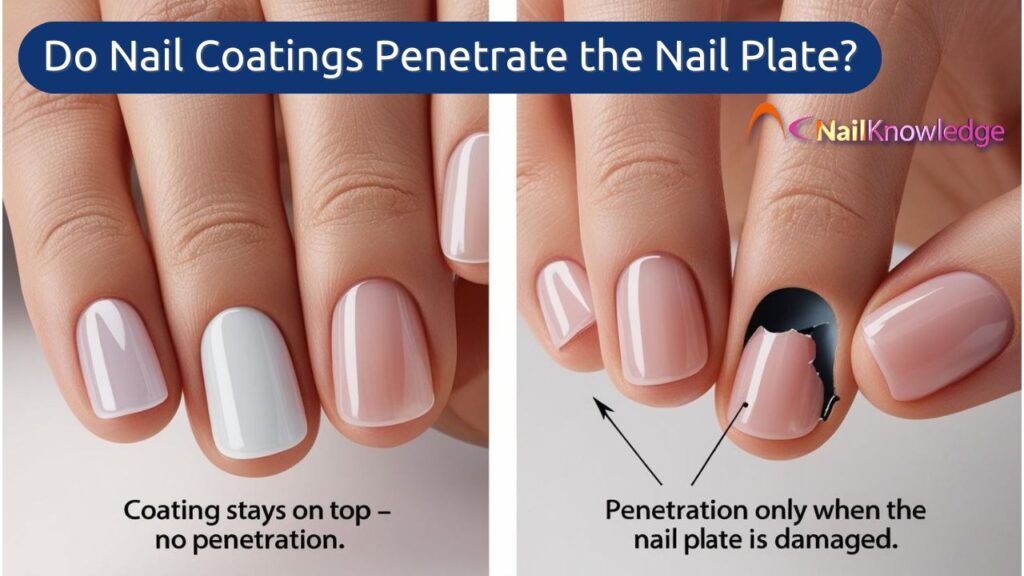We’ve all heard the chatter on social, in salons, maybe even whispered in the corner of a nail tech class. “Gels seep into the nail bed.” “Acrylics cause lifting from the inside out.” But hold up, điều đó có thực sự đúng không? If you’ve ever paused mid-mani and wondered, Do nail coatings penetrate the nail plate?, you’re not alone. This question has sparked confusion, myths, and worry for nail enthusiasts and pros alike.
So let’s break it down together, science meets real talk style.
Cái gì thậm chí Là Móng tay?
Before we get into the juicy myth-busting, let’s take a hot second to appreciate the nail plate. Think of it like a security guard for your giường móng tay, it’s strong, smart, and surprisingly picky about what it lets through.
The nail plate is the visible, hard part of your nail. It’s made up of tightly packed keratin cells (like your hair, but flatter and harder) and acts as a natural barrier, guarding the sensitive nail bed beneath from outside elements, including chemicals. But here’s the wild part, it’s bán thấm. Nó cho phép Nước dễ dàng đi qua, nhưng hầu như mọi thứ khác? Chúc may mắn khi vượt qua bức tường keratin đó.
Ngay cả dầu dưỡng móng tay, vâng, thứ tốt mà bạn thoa một cách tôn giáo, cũng khó có thể thẩm thấu sâu hơn bề mặt. Các nghiên cứu cho thấy chúng cần một tháng hoặc lâu hơn sử dụng hằng ngày just to reach the top 10% of the plate. That’s persistence!
Lớp phủ móng tay có thấm vào phiến móng không?
Lưu ý: Không dùng cho móng tay khỏe mạnh.
Let’s get to the heart of it: Lớp phủ móng có thấm vào phiến móng không?
Câu trả lời ngắn gọn là gì? KHÔNG. Không nếu móng còn nguyên vẹn và khỏe mạnh.
Whether it’s UV gels, builder in a bottle, dip powders, or acrylic overlays, they all sit on đứng đầu of the nail plate. They’re designed to adhere to the surface, not sink into it. The myth that they burrow down to the nail bed and wreak havoc? That’s more fiction than fact.
Onycholysis, the term for when the nail lifts from the bed does happen, but coatings aren’t the villain in a typical scenario. The real culprits? Things like:
- Dũa quá mức phần móng tay
- Sử dụng quá nhiều áp lực khi chuẩn bị
- Harsh trauma (hello, stiletto nail stub!)
- Một số loại thuốc hoặc vấn đề sức khỏe
In other words, it’s not the product going rogue, it’s usually what’s done trước hoặc xung quanh sản phẩm gây ra vấn đề.
Nhưng Cái Gì? Nếu như Móng tay bị hư hỏng?
Now, let’s be real. Not all tấm móng ở trong tình trạng hoàn hảo. We’ve all been there, peeling off gel (don’t judge), over-filing to remove a stubborn top coat, or dealing with breakage. So what happens if the nail plate is nứt, vỡ, hoặc nộp quá mỏng?
That’s when things get a little dicey.
When the nail plate’s natural barrier is compromised, the coatings you apply could có khả năng reach the skin underneath. That exposure might lead to irritation, allergic reactions, or in rare cases, trigger onycholysis. Think of it like a roof with a hole, water wasn’t a problem before, but now the couch is soaked.
The key takeaway? If the nail plate is damaged, even the most gentle product can cause a reaction, not because it’s inherently “bad,” but because it’s going somewhere it was never supposed to go.
Sơn móng tay = Người chơi bề mặt, không phải thợ lặn sâu
Let’s go back to basics: Coatings are designed to be trên đầu. They bond with the surface keratin, not beneath it. They’re like the perfect topcoat to a stylish outfit. Decorative? Absolutely. Protective? Often. But invasive? Nope.
When people say, “This product caused damage,” what they often mean is:
- Việc chuẩn bị quá mạnh tay.
- The removal process wasn’t gentle.
- Móng tay đã bị tổn thương trước khi sử dụng sản phẩm.
The product didn’t tunnel its way to the nail bed like a villain in a spy movie, it just did what it was told, on the surface.
Móng tay khỏe mạnh = Lớp phủ hạnh phúc
Vậy, làm sao để duy trì nguồn năng lượng tích cực giữa móng tay và các sản phẩm yêu thích của chúng ta?
- Tránh nộp quá nhiều hồ sơ. Giữ cho lớp bảo vệ này luôn chắc khỏe và khỏe mạnh.
- Giữ móng tay khỏe mạnh. Don’t apply coatings to damaged, inflamed, or thinning nails.
- Hãy kiên nhẫn khi gỡ bỏ. Cautiously soak, rebalance but don’t rip.
- Dưỡng ẩm cho móng tay của bạn. Even if oils don’t go deep, they help prevent brittleness and keep the top layers flexible.
Bảo vệ tính toàn vẹn của móng có nghĩa là tạo cho lớp phủ móng có bề mặt sáng bóng nhất, theo cả nghĩa đen và nghĩa bóng.
Suy nghĩ cuối cùng: Biết sự thật, làm đúng
Let’s wrap this up like a glossy topcoat:
Lớp phủ móng có thấm vào phiến móng không? Trừ khi móng tay đó bị tổn thương (điều này dễ xảy ra). Vì vậy, khi sử dụng đúng cách, với sự chuẩn bị tốt và móng tay khỏe mạnh, gel, acrylic và lớp phủ của bạn sẽ đẹp ở bề mặt, không phải là kẻ xâm lược bí mật.
So the next time someone tells you that gel “seeps into your nail bed,” you can raise an eyebrow and say, “Actually, that’s not how the nail plate works.” 💁♀️
💅 Mẹo làm móng trong ngày:
If you wouldn’t sand your skin, don’t sand your nails. Chạm nhẹ nhàng = móng tay khỏe hơn và sơn móng tay bền hơn.


